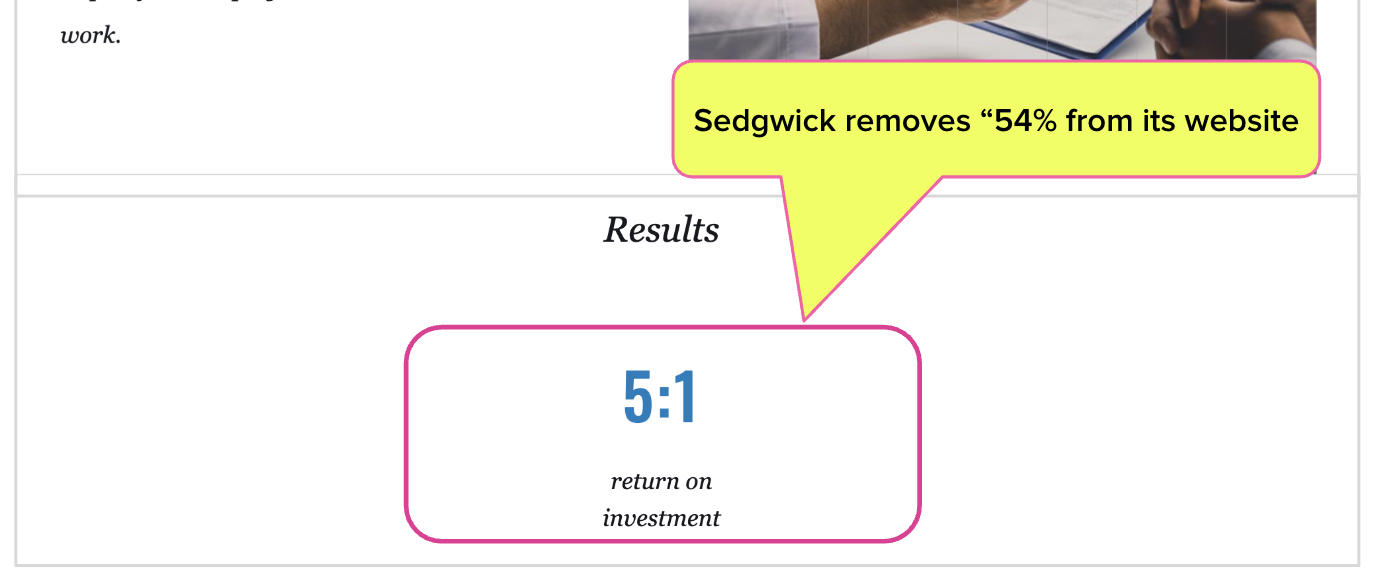Sedgwick Removes 54% UR Denial Stat From Website

We knew it was only a matter of time. The question was how much time?
Third-party administrator (TPA) Sedgwick Claims Management Services screamed the quiet part out loud by touting on its marketing website a “5:1 return on investment” resulting from the fact that “54% of treatment requests were denied/withdrawn following review.”
As predicted in this space, Sedgwick has removed the 54% statistic from the website.
We cannot assign motives (or a conscience) to Sedgwick’s openly bragging about the profits generated from a Utilization Review (UR) process that refuses more than half the care requested for injured workers. We can only alert the physician community that it should be outraged.
California physicians expend extraordinary administrative resources submitting Requests for Authorization (RFA) forms and medical records to request care. The joke is on them; by exercising zero regulatory oversight of UR, the Division of Workers’ Compensation (DWC) allows TPAs like Sedgwick to deny, ignore, and delete valid RFAs with zero consequences—and then brag about these treatment denials.
Practices churn out RFAs to care for injured workers. TPAs deny the RFAs which in turn drives up “returns on investment.” The DWC’s only response is “So what?”
Congratulations if you bet Sedgwick would drop this cynical marketing piece less than three weeks* after our previous article—someone owes you a chicken dinner.
Sedgwick Is Honest About the Role of UR: Profit
We shouldn’t have to explain why a TPA trumpeting high treatment denial rates as a selling point is tragic.
However, such is the state of workers’ comp in California, where the DWC continues to ignore Labor Code Section 4610, which requires the agency to collect every UR decision issued by California employers electronically. California legislators passed this UR law in 2016 due to fears that claims administrators may be tempted to abuse the UR process—fears that our own data suggest were well-founded.
Without the UR data demanded by California law, Sedgwick and other payers can fearlessly deny treatment and increase their profits off the backs of California’s injured employees.
Even with the 54% denial/withdrawal rate removed, the screenshot below shows Sedgwick continues to shamelessly gloat about the “Results” of its UR: a “5:1 return on investment.”
UR: Off the Rails in CA
Utilization Review (UR) is the process by which claims administrators decide whether or not to authorize the care recommended by an injured worker’s doctor.
In California, a doctor treating an injured worker must request approval for all medical care, including treatment, pharmaceuticals, and medical supplies—no care is exempt.
In California, UR has too often led to needless delays and denials of care, keeping injured workers injured for longer and ultimately increasing employers’ costs. This is a logical result of the DWC’s violating state law by refusing to collect comprehensive UR data to monitor for abuse and non-compliance.
With California claims taking twice as long (seven years) to close and costing twice as much in administrative expenses (49 cents for every dollar’s worth of benefit) compared to the rest of the nation, the state’s current approach to UR is clearly not working.
Or rather, it isn’t working for injured workers and their doctors, but is working spectacularly for TPAs, various vendors, and the private equity firms invested across the process.
The longer an injured worker remains injured, the more UR, bill review, network shenanigans, and other profitable administrative activities are required. In California, an injured worker is a seven-year annuity generating an enormous return on investment for firms like Sedgwick’s private equity owner, the Carlyle Group.
So why now? Why did Sedgwick suddenly decide that its sky-high treatment denial rate was no longer something to be proud of? We can only speculate.
While Sedgwick has enjoyed apparent immunity from any repercussions for the consistent, well-documented non-compliance we routinely report to the DWC, the TPA may not be entirely immune to bad PR. Perhaps the DWC itself would prefer Sedgwick’s impunity not be flouted, lest pressure mount for the DWC to…y’know, do its job.
We cannot consider Sedgwick’s decision to delete its disturbing statistic a victory. With the DWC's continued indifference, this unmonitored TPA can (and will) continue to deny injured workers’ care at high rates—only with slightly less publicly displayed chutzpah.
*The 54% statistic has been missing since at least October 8, 2024
Submit RFAs in 30 seconds and automatically track UR decisions with daisyAuth. Request a demo below!
REQUEST DEMO
DaisyBill provides content as an insightful service to its readers and clients. It does not offer legal advice and cannot guarantee the accuracy or suitability of its content for a particular purpose.






